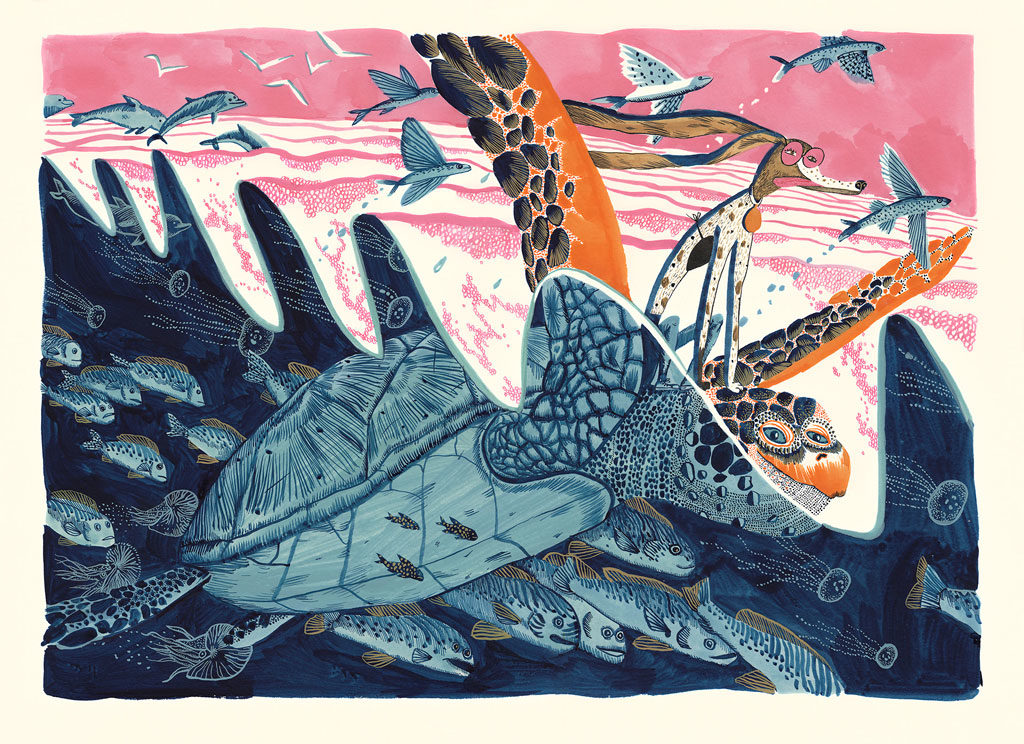The 2020 Creative Trends to Know Now
With the new year just around the corner, it’s time to familiarise yourself with the graphic design, illustration, branding and photography trends that are set to make waves in 2020.
From refashioned Didone typefaces to vintage-tinted visions of the future, as well as leanings towards inclusivity and diversity as subjects for creative content, 2020 is set to be a year of innovation, intellect and exceptional creativity in design.
Discover our predictions of the seven biggest creative trends for the year ahead below.

1. Flat Gradients
Gradients have been a firm fixture across graphic design and illustration for the last couple of years, and this macro-trend shows no sign of slowing down. In 2020, we’ll see an evolution, or perhaps better described as a devolution, of the gradient technique.
Graphic designers and illustrators will aspire to incorporate gradients into flat designs, and colors will be more muted and earthy than the neon brights that dominated in 2019. Retro-inspired shapes and drawing styles will complement these more subdued gradient styles.


2. Vintage Illustrations of Future Concepts
What will the future look like? And, more importantly, will it be a better or scarier place to live in? Concepts like Artificial Intelligence (AI), Augmented Reality (AR),Virtual Reality (VR) and the surveillance state are controversial topics, sparking both optimistic opinion and doomsaying.
Framing these mysterious and contentious subjects in a way that makes them feel approachable is a useful technique for publishers looking to release future-themed content that explores both sides of the coin. In the year ahead we’ll see illustrators using vintage styles to convey advanced technological and futuristic concepts.
Lithuanian illustrator Karolis Strautniekas, favourite of Forbes, The New Yorker and others, is especially adept at making the future seem both nostalgically comforting and enigmatically mysterious.



3. Decorative Didone Typefaces
Modern serif typefaces such as Didot and Bodoni have long been the go-to type style for high-end magazine and fashion brands, but they risk looking a little stuffy and elitist.
In 2020 we’ll see designers reclaiming the typefaces beloved by Vogue and Harper’s Bazaar and refashioning them for a new wave of female-focussed and feminist brands and publications.
Particularly impactful set as logos and headlines, these reformed Didone styles strike a clever balance between ornate decoration and minimalist elegance, with Parachute Typefoundry’s PF Marlet font spearheading the move towards ornate humanist serifs.




4. Diversity and Inclusion in Illustration
Despite more attention being given to the inclusivity of minority groups in film, television and written content, the design world has been a little slower to catch up.
Now, a renewed focus on the issue of inclusivity in the design community is raising awareness of the lack of visibility of minorities in design output, as well as the lack of accessibility that many people experience when engaging with websites and other visual content.
Illustrators in particular are generating work that situates diversity and inclusion at its heart. In the coming year we’ll see more design that directly engages with these topics, framing people with disabilities and other minority groups in a more authentic and inclusive light.

5. Authentic Women in Photography
In reaction to over-polished Instagram posts, contemporary audiences in 2020 will expect more honesty and frankness in visual content. Female-targeted brands should take note.
Female audiences in particular respond to designs that feature women who are authentic. A growing trend in photography is the complete absence of retouching, with a visible rawness and freshness to images that resonate with audiences seeking more meaningful engagements with brands.
Body modifications such as piercings and tattoos, as well as scarring, stretchmarks and skin pigmentation, will not only be shown in photographs, but highlighted. A focus on ageing and body diversity follows broad and growing trends in the fashion industry, and this will spill over into photography for branding, events and publishing.



6. Surrealism
1930s-inspired trends are going to be influential in 2020 (see also Painterly Modernism, below), and the leaning towards a more surrealist and off-kilter aesthetic across design, illustration and photography is an exciting trend to look out for.
Some illustrators are already adept at combining surrealist themes with a contemporary aesthetic. Japanese illutrator Kazuhisa Uragami crafts serene scenes with an innate quietness—a silence that makes the surreal elements palatable.

Dutch illustrator Katsiaryna Dubovik also translates surrealism into a format that feels escapist and comforting, rather than disarming, making her work perfectly suited to children’s illustrations.

In photography, Fernando Domínguez Cózar builds digital ‘growths’ onto human subjects to create surprisingly beautiful portraits that retain an eerie medicinal surrealism.

7. Painterly Modernism
Another 1930s-influenced trend that we predict will be dominant across print and web design is a leaning towards Painterly Modernism. This style combines abstract elements with a painterly, hand-done aesthetic.
Similar to vintage cafe posters, this style nonetheless feels contemporary through quirky subject matter, rich colours and bold, graphic layouts. Animated versions of these designs will also bring modernist-inspired material to life on digital platforms, adding an elegant vintage touch to websites and apps.
Look to the work of Italian illustrator Riccardo Guasco, who has turned his hand to brands including Fendi and Martini, for ultimate Painterly Modernism inspiration.



Looking for more design inspiration? Check out more trends, design tips and font lists right this way.

